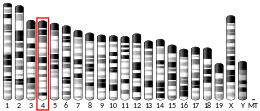MMP16
Matrix metalloproteinase-16 is an enzyme that in humans is encoded by the MMP16 gene.[5][6]
Proteins of the matrix metalloproteinase (MMP) family are involved in the breakdown of extracellular matrix in normal physiological processes, such as embryonic development, reproduction, and tissue remodeling, as well as in disease processes, such as arthritis and metastasis. Most MMP's are secreted as inactive proproteins which are activated when cleaved by extracellular proteinases. This gene produces at least two transcripts, one which encodes a membrane-bound form and another a soluble form of the protein. Both forms of the protein activate MMP2 by cleavage. This gene was once referred to as MT-MMP2, but was renamed as MT-MMP3 or MMP16.[6]
References
- GRCh38: Ensembl release 89: ENSG00000156103 - Ensembl, May 2017
- GRCm38: Ensembl release 89: ENSMUSG00000028226 - Ensembl, May 2017
- "Human PubMed Reference:". National Center for Biotechnology Information, U.S. National Library of Medicine.
- "Mouse PubMed Reference:". National Center for Biotechnology Information, U.S. National Library of Medicine.
- Takino T, Sato H, Shinagawa A, Seiki M (Nov 1995). "Identification of the second membrane-type matrix metalloproteinase (MT-MMP-2) gene from a human placenta cDNA library. MT-MMPs form a unique membrane-type subclass in the MMP family". J Biol Chem. 270 (39): 23013–20. doi:10.1074/jbc.270.39.23013. PMID 7559440.
- "Entrez Gene: MMP16 matrix metallopeptidase 16 (membrane-inserted)".
Further reading
- Nagase H, Woessner JF (1999). "Matrix metalloproteinases". J. Biol. Chem. 274 (31): 21491–4. doi:10.1074/jbc.274.31.21491. PMID 10419448.
- Andersson B, Wentland MA, Ricafrente JY (1996). "A "double adaptor" method for improved shotgun library construction". Anal. Biochem. 236 (1): 107–13. doi:10.1006/abio.1996.0138. PMID 8619474.
- Mattei MG, Roeckel N, Olsen BR, Apte SS (1997). "Genes of the membrane-type matrix metalloproteinase (MT-MMP) gene family, MMP14, MMP15, and MMP16, localize to human chromosomes 14, 16, and 8, respectively". Genomics. 40 (1): 168–9. doi:10.1006/geno.1996.4559. PMID 9070935.
- Shofuda K, Yasumitsu H, Nishihashi A (1997). "Expression of three membrane-type matrix metalloproteinases (MT-MMPs) in rat vascular smooth muscle cells and characterization of MT3-MMPs with and without transmembrane domain". J. Biol. Chem. 272 (15): 9749–54. doi:10.1074/jbc.272.15.9749. PMID 9092507.
- Yu W, Andersson B, Worley KC (1997). "Large-Scale Concatenation cDNA Sequencing". Genome Res. 7 (4): 353–8. doi:10.1101/gr.7.4.353. PMC 139146. PMID 9110174.
- Sato H, Tanaka M, Takino T (1997). "Assignment of the human genes for membrane-type-1, -2, and -3 matrix metalloproteinases (MMP14, MMP15, and MMP16) to 14q12.2, 16q12.2-q21, and 8q21, respectively, by in situ hybridization". Genomics. 39 (3): 412–3. doi:10.1006/geno.1996.4496. PMID 9119382.
- Matsumoto S, Katoh M, Saito S (1998). "Identification of soluble type of membrane-type matrix metalloproteinase-3 formed by alternatively spliced mRNA". Biochim. Biophys. Acta. 1354 (2): 159–70. doi:10.1016/s0167-4781(97)00120-6. PMID 9396633.
- Terp GE, Christensen IT, Jørgensen FS (2000). "Structural differences of matrix metalloproteinases. Homology modeling and energy minimization of enzyme-substrate complexes". J. Biomol. Struct. Dyn. 17 (6): 933–46. doi:10.1080/07391102.2000.10506582. PMID 10949161. S2CID 1270176.
- Iida J, Pei D, Kang T (2001). "Melanoma chondroitin sulfate proteoglycan regulates matrix metalloproteinase-dependent human melanoma invasion into type I collagen". J. Biol. Chem. 276 (22): 18786–94. doi:10.1074/jbc.M010053200. PMID 11278606.
- Strausberg RL, Feingold EA, Grouse LH (2003). "Generation and initial analysis of more than 15,000 full-length human and mouse cDNA sequences". Proc. Natl. Acad. Sci. U.S.A. 99 (26): 16899–903. Bibcode:2002PNAS...9916899M. doi:10.1073/pnas.242603899. PMC 139241. PMID 12477932.
- Jung M, Römer A, Keyszer G (2003). "mRNA expression of the five membrane-type matrix metalloproteinases MT1-MT5 in human prostatic cell lines and their down-regulation in human malignant prostatic tissue". Prostate. 55 (2): 89–98. doi:10.1002/pros.10194. PMID 12661033. S2CID 21596144.
- Takino T, Koshikawa N, Miyamori H (2003). "Cleavage of metastasis suppressor gene product KiSS-1 protein/metastin by matrix metalloproteinases". Oncogene. 22 (30): 4617–26. doi:10.1038/sj.onc.1206542. hdl:2297/2668. PMID 12879005. S2CID 10007952.
- Rozanov DV, Hahn-Dantona E, Strickland DK, Strongin AY (2004). "The low density lipoprotein receptor-related protein LRP is regulated by membrane type-1 matrix metalloproteinase (MT1-MMP) proteolysis in malignant cells". J. Biol. Chem. 279 (6): 4260–8. doi:10.1074/jbc.M311569200. PMID 14645246.
- Lang R, Braun M, Sounni NE (2004). "Crystal structure of the catalytic domain of MMP-16/MT3-MMP: characterization of MT-MMP specific features" (PDF). J. Mol. Biol. 336 (1): 213–25. doi:10.1016/j.jmb.2003.12.022. PMID 14741217.
- Shofuda T, Shofuda K, Ferri N (2004). "Cleavage of focal adhesion kinase in vascular smooth muscle cells overexpressing membrane-type matrix metalloproteinases" (PDF). Arterioscler. Thromb. Vasc. Biol. 24 (5): 839–44. doi:10.1161/01.ATV.0000126680.78500.4c. PMID 15044209. S2CID 22959266.
- Wang SC, Lien HC, Xia W (2004). "Binding at and transactivation of the COX-2 promoter by nuclear tyrosine kinase receptor ErbB-2". Cancer Cell. 6 (3): 251–61. doi:10.1016/j.ccr.2004.07.012. PMID 15380516.
- Gerhard DS, Wagner L, Feingold EA, et al. (2004). "The Status, Quality, and Expansion of the NIH Full-Length cDNA Project: The Mammalian Gene Collection (MGC)". Genome Res. 14 (10B): 2121–7. doi:10.1101/gr.2596504. PMC 528928. PMID 15489334.
- Kimura K, Wakamatsu A, Suzuki Y (2006). "Diversification of transcriptional modulation: Large-scale identification and characterization of putative alternative promoters of human genes". Genome Res. 16 (1): 55–65. doi:10.1101/gr.4039406. PMC 1356129. PMID 16344560.
External links
- The MEROPS online database for peptidases and their inhibitors: M10.016
- Overview of all the structural information available in the PDB for UniProt: P51512 (Matrix metalloproteinase-16) at the PDBe-KB.
This article is issued from Wikipedia. The text is licensed under Creative Commons - Attribution - Sharealike. Additional terms may apply for the media files.








